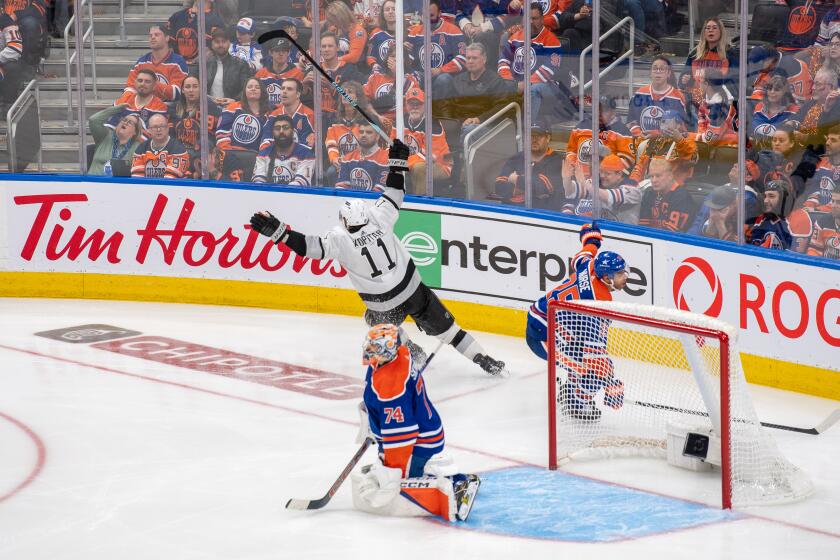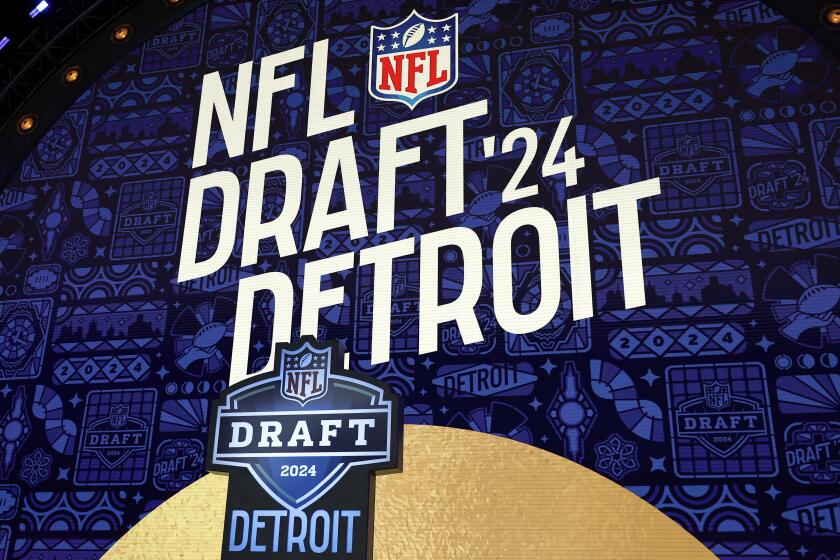NCAA tournament region-by-region previews
MIDWEST REGIONAL
Top-seeded teams
No. 1 Kansas: Guard Sherron Collins and center Cole Aldrich turned their backs on the NBA draft to get another crack at an NCAA title. The Jayhawks begin the tournament as the top-seeded team overall.
No. 2 Ohio State: The Buckeyes are not the biggest team but cause match-up problems by starting five players between 6 feet 5 and 6-8, four of whom can play guard.
No. 3 Georgetown: The paranoia should be with the Hoyas’ opponents. Georgetown has a solid backcourt and a dominating big man. Sound familiar?
No. 4 Maryland: The Terrapins were building to a hot finish, then were dumped by Georgia Tech in an Atlantic Coast Conference tournament semifinal. They could meet again in this regional’s final.
Cinderella search
Oklahoma State has beaten Kansas and Kansas State this season, so top-10 teams won’t awe the Cowboys, who can put up points in a hurry.
Top players
Evan Turner, guard/forward, Ohio State: Turner carried the Buckeyes through the Big Ten tournament, which should improve his NBA draft status. But, really, how much higher can he go? The 6-7 Turner is already projected as the No. 2 pick.
Greivis Vasquez, guard, Maryland: Vasquez, from Caracas, Venezuela, is the only player in ACC history to have 2,000 points, 700 assists and 600 rebounds. A few NCAA victories here and he becomes a Terrapin legend.
Greg Monroe, center, Georgetown: This wouldn’t be a truly great Hoyas team without a beast of a big man. Monroe is the latest to pick up the Patrick Ewing legacy. He averages 16 points and nearly 10 rebounds per game.
Rim shots
The regional features three players of the year from power conferences: Turner, Vasquez and James Anderson of Oklahoma State. Anderson averages 22 points per game. He had 27 points in the Cowboys’ upset of Kansas and 30 in his team’s upset of Kansas State.
San Diego State is led by 6-7 freshman Kawhi Leonard, the team’s leading scorer (12.8) and rebounder (9.9). But, come on, how far does Coach Steve Fisher think a freshman can take a team in the NCAA tournament?
Twice Ohio has needed to win only one game to get to face the Ohio State University in the tournament. But Ohio lost to Georgia Tech in 1960 and Louisville in 1961. The two teams could meet in the Sweet 16 this season. If Ohio gets there, it will be because guard Armon Bassett continues to sizzle. He is averaging 29 points in the last four games.
Lehigh, making its fourth tournament appearance, has never been given much of a chance. The Mountain Hawks were matched against Georgetown, a No. 1 seeded team in 1985, and Temple, a No. 1 seeded team in 1988. Lehigh would have played No. 1 Kentucky in 2004, but it lost to Florida A&M in the play-in game.
-- Chris Foster
WEST REGIONAL
Top-seeded teams
No. 1 Syracuse: The Orange took the last of the regional top seedings despite a two-game losing streak and a quadriceps injury that could sideline senior center Arinze Onuaku. Coach Jim Boeheim said Onuaku was not expected to play in a first-round game Friday against Vermont. Onuaku said his leg was “getting better.”
No. 2 Kansas State: This will be the Wildcats’ 24th tournament appearance and the highest they’ve been seeded. Kansas State has won at least two games in 16 of its 23 previous tournaments.
No. 3 Pittsburgh: The Panthers have made the last nine NCAA tournaments and have advanced to the Sweet 16 in five of the previous eight. But they are only 6-5 against other tournament teams this season.
No. 4: Vanderbilt: The Commodores finished second in the Southeastern Conference East but were otherwise rarely tested. Vanderbilt was 2-0 in nonconference games against tournament teams, beating St. Mary’s, 72-70, on the road, and Missouri, 89-83, at home.
Cinderella search
Texas El Paso has played this role before, upsetting Kentucky in the 1966 NCAA final in one of college basketball’s landmark games. The Miners are physical, can shoot (47.6%) and have a play-making guard in Julyan Stone.
Top players
Wesley Johnson, forward, Syracuse: The Big East Conference player of the year didn’t let a late-season hand injury slow him down. He averages 15.7 points and 8.5 rebounds and even shoots better than 38% from three-point range.
Jimmer Fredette, guard, Brigham Young: He is among the nation’s leading scorers with a 21.7 average, shoots 44.8% from three-point range and 89.6% (206 of 230) from the free-throw line.
Jordan Crawford, guard, Xavier: This will be Crawford’s second tournament. His first, as a freshman for Indiana, ended in a one-game, zero-points-in-21-minutes appearance. He’s averaging 19.7 points in his first season with the Musketeers.
Rim shots
The parents of Kris and Maurice Joseph have some details to work out. Kris is a 6-foot-7 sophomore forward for Syracuse. He averages 11.3 points and 5.4 rebounds and, because of Onuaku’s injury, might get a start against Vermont — which is captained by his older brother, Maurice, a 6-4 senior guard who is averaging 14.1 points.
Syracuse and Murray State are the only Division I teams that as a team shot better than 50% while holding opponents to under 40% shooting. The last team to claim that distinction, North Carolina last season, won the national championship.
Brigham Young can score. The Cougars, who average 83.0 points, shoot 48.6% and are also among the nation’s leaders from three-point range (41.9%). Oh, and Tyler Haws is one freshman you don’t want to put on the line at crunch time. He has made 100 of 110 free throws (90.9%).
-- Mike Hiserman
EAST REGIONAL
Top-seeded teams
No. 1 Kentucky: Coach John Calipari guided Massachusetts and Memphis to the Final Four and is now in position to match Rick Pitino’s feat of doing it at three different schools.
No. 2 West Virginia: With a starting lineup entirely made up of players from the New York metropolitan area, the Mountaineers won their first Big East Conference tournament title.
No. 3 New Mexico: The Lobos open in San Jose, the start of a journey that could give Coach Steve Alford a triumphant return to the Hoosier state for the Final Four.
No. 4 Wisconsin: The Badgers limit opponents to 56.1 points a game, third fewest in the nation.
Cinderella search
Cornell, with a core of seniors, lost one Ivy League game. Its only other losses came against Seton Hall, Kansas and Syracuse.
Top players
John Wall, guard, Kentucky: The freshman is averaging 16.9 points and 6.2 assists a game for a team that also includes freshman forward DeMarcus Cousins among others.
Da’Sean Butler, forward, West Virginia: The senior averages 17.4 points and has made multiple game-winning shots this season, including one in the Big East tournament title game against Georgetown.
Ryan Wittman, forward, Cornell: Wittman is 12th nationally in three-point shooting, making 43.4% of his attempts for a team that ranks first in three-point shooting.
Rim shots
Texas might be the most unpredictable, and dangerous, team in the tournament. The Longhorns started 17-0 and were ranked No. 1 before a 7-9 finish.
Wofford, a liberal arts school in Spartanburg, S.C., won the Southern Conference and is making its first NCAA appearance. The Terriers would need to win twice to possibly meet Kentucky, making its 50th tournament appearance.
Morgan State, with former California Coach Todd Bozeman, is in the NCAA tournament for the second consecutive season.
Washington was winless in its first seven games away from Seattle, but has gone unbeaten in seven road or neutral-court games since.
-- Gary Klein
SOUTH REGIONAL
Top-seeded teams
No. 1 Duke: The committee might have been generous with this seeding, but there’s some serious history with a team that just won its 18th Atlantic Coast Conference tournament title and grabbed a No. 1 regional seeding for the 11th time.
No. 2 Villanova: Another unexpected seeding. The Wildcats (24-7) have lost five of their last seven games and went 3-5 against teams in the top 25 in the RPI this season.
No. 3 Baylor: The Bears amassed a 25-7 record that includes victories over Xavier, Texas and Texas A&M. They took Kansas down to the wire before losing in late January.
No. 4 Purdue: Junior forward Robbie Hummel is gone for the season with a knee injury, but the Boilermakers can feel good about earning a share of their first Big Ten Conference title since 1996 and winning 13 of their last 15.
Cinderella search
As the No. 13-seeded team, Siena has a strong rebounder in forward Ryan Rossiter and a guard, Ronald Moore, who takes care of the ball. That’s a good combination in tournament play.
Top players
Scottie Reynolds, guard, Villanova: Though he lost out on Big East player of the year, Reynolds was the only unanimous pick on the all-conference team, averaging 18.5 points and 3.3 assists.
Omar Samhan, center, St. Mary’s: Samhan does it all for the Gaels, averaging 20.9 points and 11 rebounds.
Tweety Carter, guard, Baylor: The 5-foot-11 senior ranks sixth in the nation with 6.2 assists a game and provides tons of leadership. Besides, how can you resist a guy named Tweety?
Rim shots
Duke will live and die by the heart of its lineup. Upperclassmen Jon Scheyer, Kyle Singler and Nolan Smith average between 17.3 and 18.6 points a game.
California will play the percentages: Guard Jerome Randle makes 92.8% of his free throws (second best in the nation) and forward Jamal Boykin shoots 59.8% (also second best) from the field.
Villanova limped into the tournament with an inconsistent finish, but the Wildcats won 20 games for the sixth consecutive season and Coach Jay Wright is 11-5 in NCAA tournament play.
Not many teams can begin the season 0-11 and still make the tournament. Arkansas Pine Bluff did, winning 13 of its last 16, including the Southwestern Athletic Conference tournament title.
-- David Wharton
More to Read
Get our high school sports newsletter
Prep Rally is devoted to the SoCal high school sports experience, bringing you scores, stories and a behind-the-scenes look at what makes prep sports so popular.
You may occasionally receive promotional content from the Los Angeles Times.






